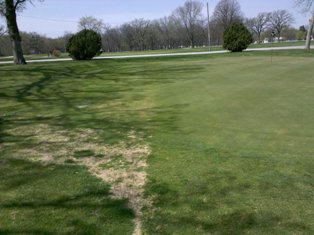By Andrew Hoiberg, PhD
The importance of calcium in any plant/soil system cannot be overstated. It is both a vital nutrient for plants and essential cation in soil, found in great quantities in both environments, making it somewhat unique in comparison to other elements. Although technically considered a secondary macronutrient, its level in turfgrass plants ranks third after nitrogen and potassium. Despite the relative importance of calcium, it is often ignored or simply taken for granted by those managing the plant/soil system.
Calcium plays many roles in plant health, the most recognizable being its role in strengthening cell walls and within cells to maintain osmotic balance, thereby stabilizing cell membranes. Since calcium is an important component of cell walls, its presence is also important in the presence of plant stressors as cell walls are normally one of the first areas invaded by pests. Calcium binds to pectin chains in turf cell walls, giving them stability and rigidity and also is necessary for the secretion of lubricating mucilage at root tips to aid in penetrating the soil. With a healthy root system and strong cell walls being important components of traffic tolerance, you can see how important calcium is on a highly trafficked athletic field. Calcium also plays an important part in the uptake of potassium and magnesium, which are both regulated by the amount of calcium ions found within the plant; a calcium deficiency results in increased susceptibility to red thread and Pythium blight.
The main reason that calcium is generally ignored in the turfgrass arena is that true calcium deficiency in grasses is rare. Monocots such as turf have a relatively low requirement for calcium when compared to dicots, with typical ranges from 0.3 to 1.25% and 0.5 to 2.0% and higher, respectively. Due to low cation exchange capacity and higher leaching potential, sand-based athletic fields may be one area that turf managers should monitor calcium levels in the plant and apply supplemental applications as necessary to ensure strong, healthy turf that will resist disease and traffic pressure. If deficiency does show up, it is displayed on new leaves that appear distorted, reddish-brown in color, and may wither and die; shortened and stunted roots may also result and are the predominant deficiency symptom in soils that contain toxic levels of aluminum, magnesium, hydrogen, and sodium that outcompete calcium on cation exchange sites.
Many soils in the United States contain sufficient calcium, which makes it easy to ignore. Soils in the Midwestern US routinely contain upwards of 80% calcium on base saturation in soil tests. However, turf mangers who deal with soils that are aided by calcium-based soil amendment applications know well the importance of them in their management programs. Soils in the both the western and SE United States are ones traditionally associated with benefitting from calcium-based soil amendment applications. In the west, sodic soils are a widespread problem, and in the SE, low pH and subsequent aluminum toxicity are widespread. The mechanisms in which calcium solves these problems are different, but similar. In sodic soils, calcium is applied to replace sodium on cation exchange sites, allowing the sodium to be leached from the soil profile. Removing the sodium improves soil structure via flocculation, or ‘bringing together’ of soil colloids, which create aggregates, which are partially responsible for creating pore space in soils. Sodium is considered a dispersive cation and will create problems with infiltration, crusting, and seedling emergence. In soils with high levels of exchangeable aluminum, calcium sulfate (gypsum) applications help to suppress the aluminum by forcing it to react with the sulfate, creating aluminum sulfate and other compounds which are less toxic or not available for plant uptake.
Low pH is another area where calcium-based soil amendments are helpful in turfgrass. Calcitic limestone (calcium carbonate) is the predominant material used in most of the US to ameliorate low pH soils to help improve nutrient use efficiency and overall growing conditions. Although most turfgrasses tend to grow in a wide range of pH, it’s an important agronomic principle for turf managers to keep an eye on and maintain in acceptable range. Dolomitic limestone (calcium/magnesium carbonate) should be used where magnesium is deficient.
Increasingly, more turf managers are using effluent water for their athletic fields, which can contain appreciable amounts of sodium, leading to problems where calcium-based product applications (i.e. gypsum) may become necessary. Similarly, as usage and weather patterns change across parts of the upper Midwest, sodic soils are becoming more widespread. Researchers at Colorado State University are examining the beneficial use of calcium-based soil amendments to reclaim soils that receive heavy sodium loads from effluent water. It is important to have water tested before using so you can develop a plan to combat any potential problems the water may cause.
Many people are confused as to the difference between saline and sodic soils, and this is an important distinction when it comes to gypsum soil amending. Sodic soils are exactly that, containing appreciable sodium, and saline soils can contain a wide variety of salts that need to be leached, not necessarily displaced by the calcium in gypsum. Soil testing should form the foundation of your maintenance program in these situations and contacting your local university extension service or fertilizer dealer can help you differentiate between these difficult soil types and where amending is appropriate.
Calcium is an extremely important element in any turfgrass environment, and its abundant presence, absence, or being overshadowed can make it easy to ignore or in high demand. Being able to identify where calcium-based products are needed is an important part of providing suitable growing conditions for your fields.
The author is director of research and development for Calcium Products, Ames, IA.



